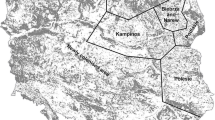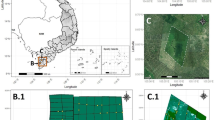Abstract
The Northern pig-tailed macaque is listed as Endangered in India and vulnerable globally. In this study, we assessed the status and behavioral activities of Northern pig-tailed macaque (Macaca leonina) in the Inner Line Reserve Forest (ILRF). Population study was conducted through complete count method. A total of 29 individuals were found in three separate troops. We studied the activity profile of the species following a focal female individual of a selected troop and have obtained information on the anthropogenic threats and other conservation issues in the forest. Eight behavioral activities (viz., feeding, resting, locomotion, playing, grooming, vocalization, agonistic and mating) were recorded both in the summer and winter seasons. The activity budgets of the Northern pig-tailed macaque varied with the seasons and most of the times were spent on locomotion followed by feeding, resting, playing, vocalization and other three behavioral activities. During winter, over three-fourth of the time was spent on four major activities such as locomotion (31.7%), feeding (25.1%), resting (14.3%), and vocalization (9.7%). Although, time spent on locomotion (25.0%) was also highest in summer, however, time spent in resting (24.6%) and playing (15.6%) increased in the season than the time spent in feeding (15.0%). Potential threats were identified through questionnaire surveys of the people inhabited in and around forest. Multistage sampling method was used to select the villages at first and then respondents from the selected villages. One-fourth of the respondents constitute 159 of the total 637 household and additional 51 respondents comprising elder person, hunter and forest staff. As per peoples’ perceptions, the main threats faced by the macaque were timber logging (44.90%), followed by cultivation (30.96%), harvesting of non-timber forest product (8.88%), hunting (6.34%), illegal trade/poaching (5.83%) and forest fire (3.04%). A proper conservation action plan is needed for the species that should ideally include providing alternative livelihoods to the forest villagers to reduce peoples’ impact on the forest.


Similar content being viewed by others
References
Ahmed T, Naher H (2021) population status of northern pig-tailed Macaque Macaca leonina IN Satchari National Park. Bangladesh Asian Primates J 9(1):32–40
Albert A, Huynen MC, Savini T, Hambuckers A (2013) Influence of food resources on the ranging pattern of northern pig-tailed macaques (Macaca leonina). Int J Primatol 34:696–713
Altmann J (1974) Observational study of behavior: sampling methods. Behaviour 49:226–267
Bernstein I (1967) A field study of the pigtail monkey (Macaca nemestrina). Primates 8:217–228
Boonratana R, Chetry D, Long Y, Jiang XL, Htun S, Timmins RJ (2020) Macaca leonina (errata version published in 2020). IUCN Red List Threat Species. https://doi.org/10.2305/IUCN.UK.2020-2.RLTS.T39792A186071807.en
Campbell G, Head J, Junker J, Nekaris KAI (2016) Primate abundance and distribution: background concepts and methods. In: Wich SA, Marshall AJ (eds) An introduction to primate conservation. Oxford, UK, pp 79–110
Chauhan A, Pirta RS (2010) Socio-ecology of two species of non-human primates, rhesus monkey (Macaca mulatta) and hanuman langur (Semnopithecus entellus), in Shimla, Himachal Pradesh. J Hum Ecol 30:171–177
Chetry D, Medhi R, Biswas J, Das D, Bhattacharjee PC (2003) Nonhuman primates in the Namdapha National Park, Arunachal Pradesh, India. Int J Primatol 24(2):383–388
Choudhury A (2001) Primates in Northeast India: an overview of their distribution and conservation status. Envis Bull: Wildl Prot Areas 1(1):92–101
Choudhury A (2003) The pig-tailed macaque Macaca nemestrina in India – status and conservation. Primate Conserv 19:91–98
Choudhury A (2008) Ecology and behavior of the pig-tailed macaque Macaca nemestrina leonina in some forest of Assam in north-east India. J Bombay Nat Hist Soc 105:279–291
Choudhury A (2010) Further note on some behavioural aspects of northern pigtailed macaque Macaca nemestrina leonina. J Bombay Nat Hist Soc 107:153–155
Choudhury A (2013) Mammals of northeast India. Gibbon Books and the Rhino Foundation for Nature in NE India, Guwahati, India
Choudhury A (2020) Largest group of northern pig-tailed Macaques sighted and a discussion on the species’ group size. J Bombay Nat Hist Soc 117:279–291. https://doi.org/10.17087/jbnhs/2020/v117/151898
Cotton AJ, Clark FE, Boubli JP, Schwitzer C (2016) IUCN red list of threatened primate species. In: Wich SA, Marshall AJ (eds) An introduction to primate conservation. Oxford, UK, pp 31–38
Dattagupta S, Gupta A (2014) Traditional processing of non- timber forest products in Cachar, Assam, India, traditional processing of non- timber forest products in Cachar, Assam, India. Indian J Tradit Knowl 13(2):427–433
Ding W, Zhao QK (2004) Rhinopithecus bieti at Tacheng, Yunnan: diet and daytime activities. Int J Primatol 25:583–598
Dzulhelmi MN, Suriyanti S, Manickam S (2019) Population, behaviour and conservation status of long-tailed macaque, Macaca fascicularis and Southern pig-tailed macaque, Macaca nemestrina in Paya Bakau Park, Perak, Malaysia. J Anim Plant Sci 29:611–618
El-Alami A, Chait A (2012) Seasonal variation in activity budget and diet of the endangered Macaca sylvans in the tourist valley of Ouzoud, Central High Atlas, Morocco. Mammalia 76:245–250
Estrada A, Garber PA, Rylands AB, Roos C et al (2017) Impending extinction crisis of the world’s primates: Why primates matter. Sci Adv 3(1):e1600946. https://doi.org/10.1126/sciadv.1600946
Feeroz MM (2012) Niche separation between sympatric Pig Tailed Macaque (M. leonina) and Rhesus macaque (M. mulatta) in Bangladesh. J Primatol 1(106):2
FSI (2019) Forest Survey of India. https://fsi.nic.in/forest-report-2019?pgID=forest-report-2019
Goodson NJ, Stevens DR, Bailey JA (1991) Effects of snow on foraging ecology and nutrition of bighorn sheep. J Wildl Manag 55:214–222
Hanya G (2004) Seasonal variations in the activity budget of Japanese macaques in the coniferous forest of Yakushima: effects of food and temperature. Am J Primatol 63:165–177
Hanya G, Chapman CA (2013) Linking feeding ecology and population abundance: a review of food resource limitation on primates. Ecol Res 28:183–190. https://doi.org/10.1007/s11284-012-1012-y
Hanya G, Kiyono M, Yamada A, Suzuki K, Furukawa M, Yoshida Y, Chijiiwa A (2006) Not only annual food abundance but also fallback food quality determines the Japanese macaque density: evidence from seasonal variations in home range size. Primates 47:275–278
Hanya G, Stevenson P, van Noordwijk M, Wong ST, Kanamori T, Kuze N, Aiba S, Chapman CA, van Schaik C (2011) Seasonality in fruit availability affects frugivorous primate biomass and species richness. Ecography 34:1009–1017
Hasan MK, Feeroz MM, Islam MA, Kabir MM, Begum S (2007) Substrate use by the western hoolock gibbon (Hoolock hoolock) in a semi-evergreen forest of Bangladesh. Zoos’ Print 22:2702–2705
Islam M (2016) Status survey of Hoolock gibbon Hoolockhoolock with special reference to habitat analysis food analysis and anthropogenic pressure in the Inner line Reserve Forest and its adjoining areas of Cachar district Assam. PhD Thesis, Assam University, Silchar. http://hdl.handle.net/10603/97347
Islam M, Basumatary N, Choudhury P, Sarma PK, Das A (2013) Studies on land use and land cover change using multi-temporal satellite data in the Inner-line reserve forest, Barak Valley, Assam, India. NeBIO 4(5):46–50
Jaman MF, Huffman M (2013) The effect of urban and rural habitats and resource type on activity budgets of commensal Rhesus macaques (Macaca mulatta) in Bangladesh. Primates 54:49–59
Jose-Dominguez JM, Savini T, Asensio N (2015) Ranging and site fidelity in northern pigtailed macaques (Macaca leonina) Over Different Temporal Scales. Am J Primatol 77:841–853
Khamcha D, Sukumal N (2009) Python molurus predation on a Macaca nemestrina in Khao Yai National Park, Thailand. Hamadryad 34:176–178
Kitamura S, Yumoto T, Poonswad P, Chuailua P, Plongmaiand K, Maruhashi T, Noma N (2002) Interactions between fleshy fruits and frugivores in a tropical seasonal forest in Thailand. Oecologia 133:559–572
Myers N, Mittermeier RA, Mittermeier CG, da Fonseca GAB, Kent J (2000) Biodiversity hotspots for conservation priorities. Nature 403:853–858
Oi T (1990) Population organization of wild pig-tailed macaques (Macaca nemestrina nemestrina) in West Sumatra. Primates 31:15–31
Richardson M, Mittermeier RA, Rylands AB, Konstant B (2008) Macaca nemestrina. The IUCN Red List of Threatened Species. Version 2014.1.
Riley EP (2007) Flexibility in diet and activity patterns of Macaca tonkeana in response to anthropogenic habitat alteration. Int J Primatol 28:107–133
Rodman PS (1979) Skeletal differentiation of Macaca fascicularis and Macaca nemestrina in relation to arboreal and terrestrial quadrupedalism. Am J Phys Anthropol 51:51–62
Ruppert N, Holzner A, Wei See K, Gisbrecht A, Beck A (2018) Activity budgets and habitat use of wild southern pig-tailed macaques (Macaca nemestrina) in oil palm plantation and forest. Int J Primatol 39:237–251
Sha JCM, Hanya G (2013) Temporal food resource correlates to the behavior and ecology of food-enhanced long-tailed macaques (Macaca fascicularis). Mammal Study 38:163–175
Shalauddin M, Islam MJ, Mia MR, Mia MJ, Khan MAR, Khatun UH (2020) Food and Feeding Behavior of Northern Pig-tailed Macaque (Macaca leonina, Blyth 1863) at Lawachara National Park, Bangladesh. 7th Asian Primate Symposium-2020 at Gauhati University, Guwahati, Assam, India
Singh B, Choudhury P (2020) Original Research Article A Status Survey of the Phayre’s Leaf Monkey Trachypithecus phayrei Blyth, 1847 (Primates: Cercopithecidae) within the Inner-line Reserve Forests and its Fringe Areas of Assam, India. J Bioresour 7(1):70–77. https://doi.org/10.17605/OSF.IO/QADG4
Southwick CH, Cadigan FC Jr (1972) Population studies of Malaysian primates. Primates 13:1–18
Srivastava A (1999) Primates of Northeast India. Megadiversity Press, Bikaner, India, Bikaner
Srivastava A (2006) Conservation of threatened primates of northeast India. Primate Conservation 20:107–113
Sussman RW, Shaffer CA, Guidi L (2011) Macaca fascicularis in Mauritius: implications for macaque-human interactions and for future research on long-tailed macaques. In: Fuentes A, Jones-Engel L, Gumert MD (eds) Monkeys on the edge: ecology and management of long-tailed macaques and their interface with humans. Cambridge University Press, Cambridge, pp 207–235
Talukdar NR, Choudhury P (2017) Conserving wildlife wealth of Patharia hills reserve forest, Assam, India: a critical analysis. Glob Ecol Conserv 10:126–138. https://doi.org/10.1016/j.gecco.2017.02.002
Talukdar NR, Singh B, Choudhury P (2018) Conservation status of some endangered mammals in Barak Valley, Northeast India. J Asia-Pac Biodivers 11:167–172
Talukdar NR, Choudhury P, Barbhuiya RA, Ahmad F, Daolagupu D, Baishya JB (2021) Mammals of northeastern India: an updated checklist. J Threat Taxa 13(4):18059–18098. https://doi.org/10.11609/jott.6010.13.4.18059-18098
Whitington CL (1992) Interactions between Lar gibbons and pig-tailed macaques at fruit sources. Am J Primatol 26:61–64
Wich S, Riswan J, Refsh J, Nelleman C (2011) Orangutans and the Economics of Sustainable Forest Management in Sumatra. UNEP/GRASP/PanEco/YEL/ ICRAF/GRID-Arendal. Birkeland Trykkeri AS, Norway
Acknowledgements
The authors would like to thank all the respondents for their immense contribution to the successful completion of the work. The authors are thankful to Dr. Nilam Basumatary and Dr. Mofidul Islam for proving the vegetation map of the study area. The authors are also grateful to the Editor and the four anonymous reviewers for their feedbacks and insightful suggestions to improve the manuscript.
Author information
Authors and Affiliations
Corresponding author
Ethics declarations
Conflict of interest
The authors have declared that no competing interests exist.
Consent for publication
Participants have the consent to publish the findings.
Rights and permissions
Springer Nature or its licensor holds exclusive rights to this article under a publishing agreement with the author(s) or other rightsholder(s); author self-archiving of the accepted manuscript version of this article is solely governed by the terms of such publishing agreement and applicable law.
About this article
Cite this article
Singh, B., Rahman, A., Talukdar, N.R. et al. Population, behavior and conservation status of the northern pig-tailed macaque (Macaca leonina) in the Inner-line reserve forest, Assam, India. Trop Ecol 64, 287–295 (2023). https://doi.org/10.1007/s42965-022-00276-4
Received:
Revised:
Accepted:
Published:
Issue Date:
DOI: https://doi.org/10.1007/s42965-022-00276-4




